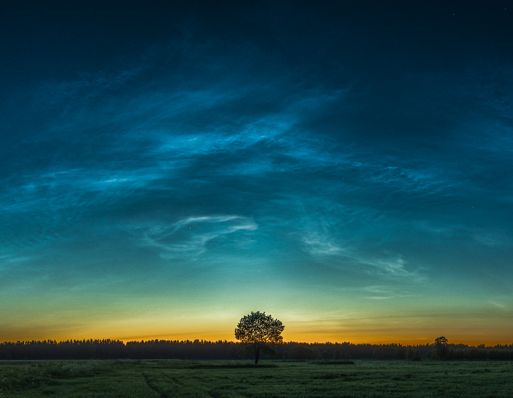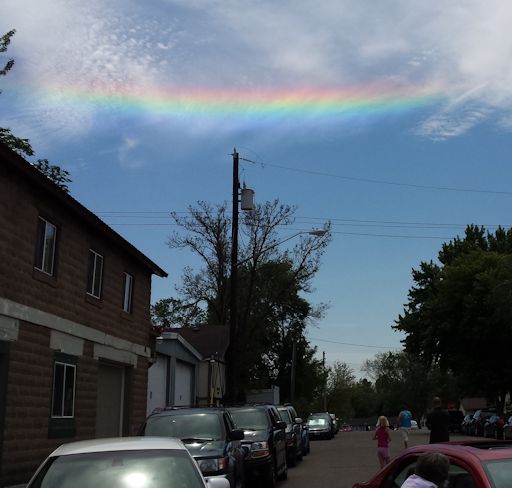Come to Tromsø and share Marianne's passion for rural photography: Chasethelighttours.co.uk invites you to experience "Heaven on Earth" with an aurora, fjord, fishing, whale watching, photography or sightseeing tour. | | |
CO-ROTATING INTERACTION REGION: NOAA forecasters estimate a 45% chance of polar geomagnetic storms on June 8th when a co-rotating interaction region (CIR) is expected to hit Earth's magnetic field. CIRs are transition zones between fast- and slow-moving solar wind streams. Solar wind plasma piles up in these regions, producing density gradients and shock waves that do a good job of sparking auroras. Aurora alerts: text, voice
WEEKEND NOCTILUCENT CLOUDS: All weekend long, ripples of electric-blue have criss-crossed the evening skies of northern Europe. Saturday night in Estonia, for instance, looked like this:

"Using my Pentax K-30 digital camera, I created a panoramic image of the display," says photographer Jüri Voit. "It was widespread and beautiful."
Summer is the season for noctilucent clouds (NLCs). They form at the edge of space, 82 km above Earth's surface, when diaphanous wisps of water vapor wrap themselves around meteoroids to form tiny ice crystals. The crystals are so tiny that they scatter blue light--hence the clouds' electric-blue color. Why summer? Ironically, that is the only time the upper atmosphere is cold enough for these icy clouds to form.
Noctilucent clouds first appeared in the 19th century after the eruption of super-volcano Krakatoa. At the time, people thought NLCs were caused by the eruption, but long after Krakatoa's ash settled, the clouds remained. In recent years, NLCs have intensified and spread with summer sightings as far south as Utah and Colorado. This could be a sign of increasing greenhouse gases in Earth's atmosphere.
Observing tips: Look west 30 to 60 minutes after sunset when the sun has dipped 6o to 16o below the horizon. If you see luminous blue-white tendrils spreading across the sky, you may have spotted a noctilucent cloud.
Realtime NLC Photo Gallery
NOT A RAINBOW: At this time of year, a colorful arc often appears in the noontime sky. It looks like a rainbow, but it's not. "We saw one during Saturday's June Bug parade in Baldwin, Wisconsin," reports Craig Braymen. "This picture barely does it justice."

Braymen witnessed a circumhorizon arc--a rainbow-colored band of light caused by the sun shining through plate-shaped ice crystals in cirrus clouds. Summer is the season for circumhorizontal arcs because they appear only when the sun is high in the sky--more than 58o above the horizon. The arc's enormous size and pure spectral colors make it one of the most beautiful of all ice halos.
At medium latitudes, like much of the USA, the arc is not rare.Typically, it can be seen several times each summer. In contrast, further north in much of Europe the circumhorizon arc is a rarity and impossible to see north of Copenhagen. See the charts in Les Cowley's web page 'How rare?' for the visibility at your location.
Realtime Space Weather Photo Gallery
Realtime Sprite Photo Gallery
Realtime Meteor Photo Gallery
Realtime Aurora Photo Gallery
Every night, a network of NASA all-sky cameras scans the skies above the United States for meteoritic fireballs. Automated software maintained by NASA's Meteoroid Environment Office calculates their orbits, velocity, penetration depth in Earth's atmosphere and many other characteristics. Daily results are presented here on Spaceweather.com.
On Jun. 7, 2015, the network reported 14 fireballs.
(14 sporadics)

In this diagram of the inner solar system, all of the fireball orbits intersect at a single point--Earth. The orbits are color-coded by velocity, from slow (red) to fast (blue). [Larger image] [movies]
Potentially Hazardous Asteroids (
PHAs) are space rocks larger than approximately 100m that can come closer to Earth than 0.05 AU. None of the known PHAs is on a collision course with our planet, although astronomers are finding
new ones all the time.
On June 7, 2015 there were potentially hazardous asteroids.
Notes: LD means "Lunar Distance." 1 LD = 384,401 km, the distance between Earth and the Moon. 1 LD also equals 0.00256 AU. MAG is the visual magnitude of the asteroid on the date of closest approach. | | The official U.S. government space weather bureau |
| | The first place to look for information about sundogs, pillars, rainbows and related phenomena. |
| | Researchers call it a "Hubble for the sun." SDO is the most advanced solar observatory ever. |
| | 3D views of the sun from NASA's Solar and Terrestrial Relations Observatory |
| | Realtime and archival images of the Sun from SOHO. |
| | from the NOAA Space Environment Center |
| | the underlying science of space weather |
| | Web-based high school science course with free enrollment |

